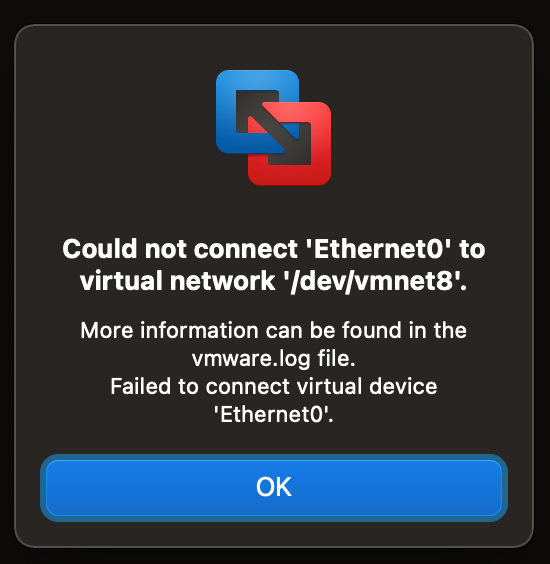Since your traffic on the vmnet8 or vmnet1 interface is relayed via a private address of your host system, you're going to see a lot of traffic to and from this address. For example, on our settings, we have 172.16.254.1 set as the NAT gateway for our virtual machines. For a bridged VMware environment, you don't need vmnet-sniffer. (Also shown are VMnet1, the default virtual network for host-only networking, and VMnet8, the default virtual network for NAT, if they are enabled in VMware Workstation.) To exclude one or more physical Ethernet adapters from the list to which VMnet0 may be bridged, click the Automatic Bridging tab.
1. Determine the MAC address of your guest machine
Let's say you have a guest machine with the name nrel-dev-centso6 and you keep your guest machine images in ~/Documents/Virtual Machines/. To determine the MAC address for this VM, you can run:
Vmware Fusion Vmnet8 Free
Copy the MAC address, e.g. 00:0c:29:59:6a:d0.


2. Add your static IP address to VMWare's dhcpd.conf
Open /Library/Preferences/VMware Fusion/vmnet8/dhcpd.conf. vmnet8 is the virtual interface for NAT networking in VMWare the guest machines. In this file, you'll see a subnet clause that looks something like this:
Take note of the line starting with range. The IP addresses you will assign your guest machines will need to fall outside that range. Find the line that looks like this:
Below that line, add a clause for your guest machine. It should look like this:
Make sure the hardware ethernet value matches the MAC address you found in step one, and the fixed-address is an IP outside the range listed in the subnet clause.
3. Optional: Update your /etc/hosts file
If you want to assign a fancy local hostname that refers to your guest machine, you can do so by editing your /etc/hosts file. For instance, to assign the hostname ubuntu.local to the guest machine we just setup, we could add the following line to our /etc/hosts file:
4. Restart the VMWare daemons
Vmware Fusion Vmxnet3

Image gallery website template. Last thing to do is restart your VMWare daemons:
Vmware Fusion Vmnet8 Download

2. Add your static IP address to VMWare's dhcpd.conf
Open /Library/Preferences/VMware Fusion/vmnet8/dhcpd.conf. vmnet8 is the virtual interface for NAT networking in VMWare the guest machines. In this file, you'll see a subnet clause that looks something like this:
Take note of the line starting with range. The IP addresses you will assign your guest machines will need to fall outside that range. Find the line that looks like this:
Below that line, add a clause for your guest machine. It should look like this:
Make sure the hardware ethernet value matches the MAC address you found in step one, and the fixed-address is an IP outside the range listed in the subnet clause.
3. Optional: Update your /etc/hosts file
If you want to assign a fancy local hostname that refers to your guest machine, you can do so by editing your /etc/hosts file. For instance, to assign the hostname ubuntu.local to the guest machine we just setup, we could add the following line to our /etc/hosts file:
4. Restart the VMWare daemons
Vmware Fusion Vmxnet3
Image gallery website template. Last thing to do is restart your VMWare daemons:
Vmware Fusion Vmnet8 Download
If you are using VMWare Fusion 6, services.sh is in a different location.

